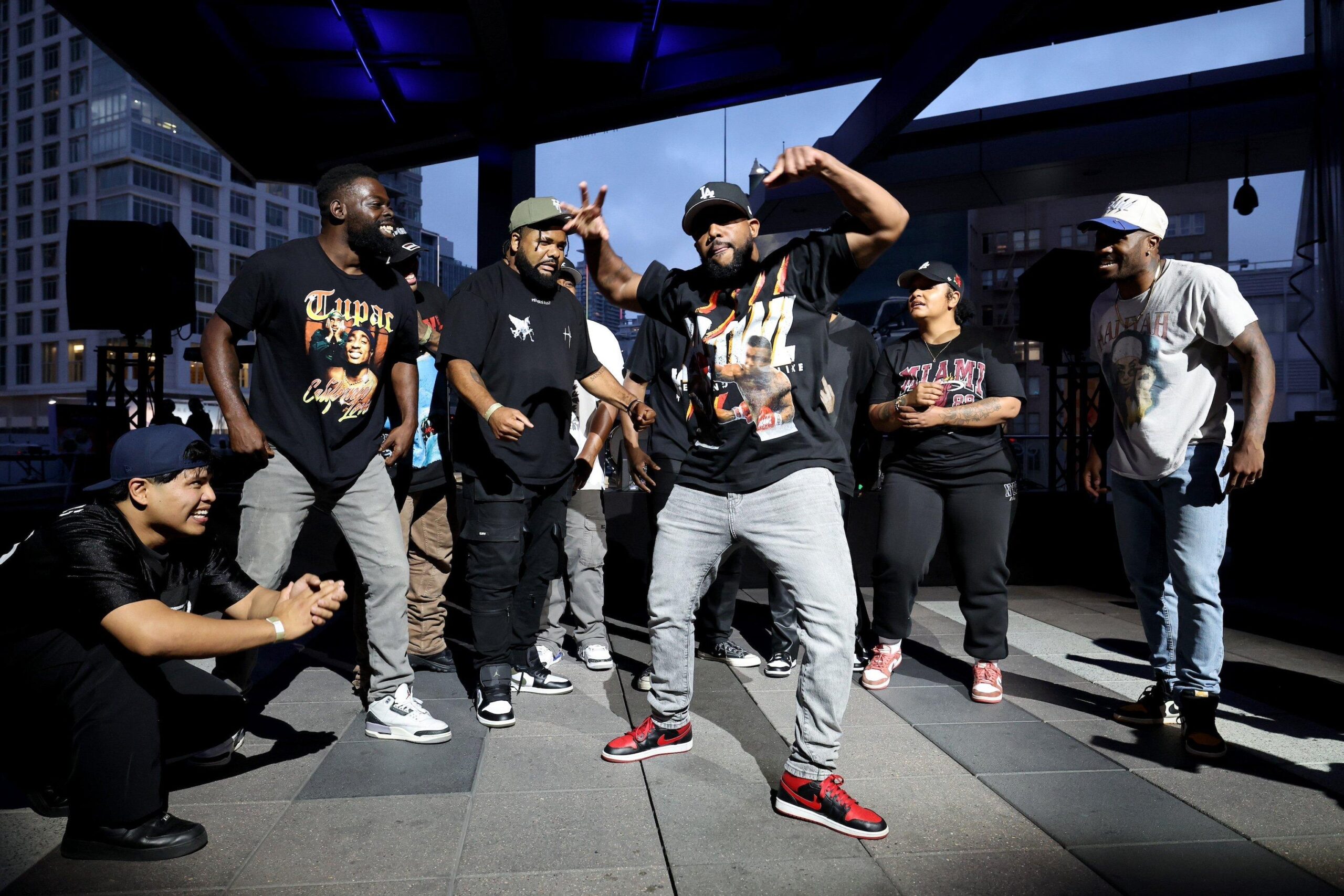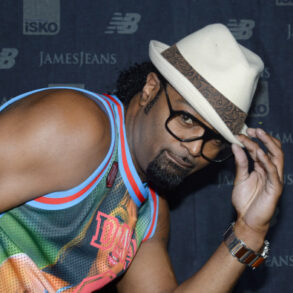
“No, Fix It.” Those three words — whispered to himself backstage after a flat calypso performance at a youth talent show — would guide Machel Montano’s four-decade mission.
While peers abandoned Caribbean sounds for foreign trends, the 9-year-old resolved to make soca irresistible again. Today, with an unprecedented 22 major monarch titles (Trinidad’s musical crowns, which are earned through lyrical warfare, social commentary, and electrifying performance battles that reclaimed cultural sovereignty), he’s transcended stardom to become soca’s guardian — a cultural architect pushing the genre beyond tropical borders.
“I could’ve never dreamed this,” Montano reflects from his Port of Spain home, his voice textured with the wisdom of an artist who evolved from child curiosity to institution.
His February 2025 album One Degree Hotter marked a volcanic return after a four-year hiatus spent earning a Master’s in Carnival Studies — deepening his command of the tradition he’s championed since childhood. “This album shows we’re better informed now,” he explains. “We’re still releasing road march bangers and competition calypsos, but we know what needs to shift to take soca worldwide.”
Montano’s discography is soca’s evolution in real time. Montano was just a wide-eyed 11-year-old when he performed “Too Young To Soca” in 1986; he expanded the sound of the genre with 1991’s diasporic “Take Me Back” then further changed the game with 1997 “Big Truck” and 2015’s swaggering “Like Ah Boss.” His recent Ne-Yo collaboration “Truth & Balance (Remix)” exemplifies his formula of honoring soca’s roots while inviting global stars into its joy.
The stats dazzle — multiple sold-out solo shows at Madison Square Garden (including two performances in one night), NPR’s Tiny Desk (a soca first), collaborations with Beyoncé, Jay-Z, and Major Lazer—yet Montano notes soberly that soca still lacks a dedicated GRAMMY Category. “I’ll keep leading the charge,” he says, “but full recognition might come from the next generation.”
In an era of algorithmic hits, Montano stands as an antidote and beacon: true artistry isn’t chasing trends, but building cultural altars where the world willingly kneels. In this GRAMMY.COM conversation, Machel Montano reflects on his career — not just as performer, but as devotee, treating each stage like sacred ground and every song as spiritual work.
The following has been edited for clarity and brevity.
I want you to talk about “Too Young To Soca.” Did you know what you were getting yourself into,? How did that experience feel then and now as you look back on it?
I could’ve never dreamed this when I started in 1984 putting my band together. I watched “Solid Gold,” and would see Sting and the Police, Guns N’ Roses with all their laser lights, big stages, Michael Jackson, the Bee Gees, and Sade. I wanted that world, but loved the technology more than fame. I’d have happily played congas in the background.
In those times with “Too Young To Soca,” there was excitement about just doing music and being a child, having fun, traveling, and touring. But now there is an understanding of the responsibility. There is an understanding of the discipline and the hard work. Sometimes it becomes heavy trying to deliver hit songs, trying to have a good Carnival season with big hits. You have a hole to fill, and you have to hold this work sacred. In 1986, I don’t think it was sacred; it was just excitement. From then to now, stepping to a microphone or stepping into a studio, writing, putting pen to paper, producing music, touching keys is a sacred space for me.
You were on “Star Search” shortly after the release of “Too Young,” correct?
I think it was 1987; this was right after I was thrust into the spotlight with “Too Young To Soca.” I went to New York, and I met Ralph MacDonald, who was a famous Trinidadian percussionist who produced tracks on the Saturday Night Fever album. He was really close to Marcus Miller. They just felt like, hey, this kid should go to “Star Search,” and they prepped me. I had a choice of what I wanted to sing between “Just The Two of Us” or “Too Young To Soca.” I prepped both songs, and in the end, I felt more comfortable singing soca.
When you chose soca over R&B and got crickets from the audience, how did that moment shape your view of Caribbean music’s global reception?
I grew up being taught calypso in school and by my parents. Starting to perform soca music, I was thrust into the calypso tents with “Too Young To Soca” — I was the only 9-year-old with everybody else 40, 50, 60, even 70-years-old. I did not see my peers. We went to some younger contests where everyone was lip-syncing New Edition, Bell Biv DeVoe and reggae music. I started singing calypso, and they looked at me as if I was doing something wrong.
I went backstage very embarrassed, very defeated. In that moment, I think I met my inner voice and asked, What do I do? Something came back and said, No, fix it. That is when you know your destiny. I spent my whole life trying to figure out how to get young people to love their culture. I started the journey of being the young soca calypso guy, blending with hip-hop, R&B, and classical music.
In getting to “Star Search,” I was already understanding that my duties were to represent my music and my people. I loved “Just The Two Of Us”, but it just didn’t feel right. I performed “Too Young To Soca,” the audience didn’t understand, and I knew I’d lose. The real win was to go there. The history books will show I did soca music in 1988 on “Star Search.” You might lose some battles, but you might win your war if your vision is aligned with listening to your inner voice.
Looking back, do you wish you had performed that R&B song?
I don’t live with regrets. I am very grateful, and I wake up every morning smiling, thinking I’m lucky. I didn’t start off wanting to be famous or wanting to win a GRAMMY. I started wanting to know how these people get these instruments onto this record, get it to sound good, and get this technology to work. That’s what I stay true to.
There were junctions in my life when I thought, if I had chosen to sing R&B, maybe I would have been an R&B star. But at this moment, the way it is, is the way it’s supposed to be. And I’ve always tried [to push the needle forward]. When I got signed in Germany, I tried. That didn’t work out. I got signed to Atlantic Records in 2000. I tried, but that didn’t work out. It moved the needle forward because I came back more knowledgeable with experience I gained from recording with Stargate in Norway, Merlin Music in Sweden, and recording with the top people in London.
I came back and applied what I learned to my industry, and I moved the whole genre forward. I’ll keep leading the charge, but full recognition [of soca] might come from the next generation. I always chose to represent my culture, and maybe I wasn’t trying to be risky enough, but that was just what I would call following your heart.
How does your new album, One Degree Hotter, reflect where you are now both as an artist and as a scholar of carnival?
This album shows we’re better informed now. It’s a bridge between everything that we were and everything that we want to be. It will show the knowledge gained from going back to school and my 40 years of experience, yet truly understanding the origins of Carnival, calypso, soca, mas, and [steel] pan.
We’re experimenting with new messages and new ways of thinking. You will see some retro styles; we brought back the drum machines of the ’80s and early ’90s. Songs like “Pardy” could internationally crossover. I’m always the artist that people get accustomed to trying different things and moving the needle. This album is that middle ground. Our real objective is to go to the next album, which is aimed at mixing Garifuna music, with Shatta, Bouyon music, with reggaeton, with afrobeats, understanding that connection between Africa and Fela Kuti to Wizkid to Burna Boy, all the way up to why it works so well in the Caribbean. We’re one degree more sensitive, hotter, closer to our goal.
We’re still releasing road march bangers and competition calypsos, but we know what needs to shift to take soca worldwide. [One Degree Hotter] speaks volumes with four or five real hits, a calypso record, a soca song that took us to the road march, a chutney that won us a chutney soca monarch, and “The Truth” where we worked with the best in R&B and dancehall.
That leads me right into my next question, which was about “Truth.” How did you link up with Ne-yo for that record?
I felt like the message of the record was resonating with him. It was a parallel to his general thinking in life, as I have observed in recent years. Musically, we’re always on par because to me, musically, Ne-yo is a genius. He always brings his A-game. I watched him loving Caribbean music, doing records with Shaggy, taking little steps out of the norm to have some fun.
I also met Ne-yo when he performed in Trinidad. Recently, I saw him collaborating with a young artist from Trinidad by the name of Sej. So when I discovered the Ayetian song during Carnival that was called “Balance,” and my song was speaking about balance, they were similar in their messages, and I just felt like experimenting and doing a mashup of my own. I called Ne-yo’s manager and found the producer. I got them on board for this collaboration. The song was during Carnival time, hitting the charts in Trinidad, playing at the parties as the only dancehall song. So I just felt like it was a match made in heaven.
Did you face skepticism about the value of pursuing a degree in Carnival studies and putting your music career on hold?
Oh, for sure. One so-called politician wrote an article and said, “What are you gonna do? Learn about whining, learn how to jump and wave?” They didn’t even know what Carnival is. On the surface, you put on a costume, you go to a fete, you drink alcohol, you whine up on somebody, and that’s it. But people like me going through it, I have proof I didn’t know anything about calypso the way I know about it now.
One of my assignments was to write a calypso. I wrote a calypso, and I won the calypso monarch competition and changed the course of history to become the only person to win what I’ve done, and at that age. It means something I learned helped me. A lot of people went to the Carnival studies program after me, and I hope to keep inspiring to have a greater frequency of people learning about their culture.
So, how many albums do you have exactly?
I stopped counting when I did an album [Album 34] and that was about maybe 5-10 years ago. I think it could be something like 49 or 50, I don’t know. But if you look at the numbers, I have more albums than the years I’ve been in this, because sometimes I had two albums in one year. I would do one Machel Montano album, and then I’d do all the HD Family albums or D Mad Bull Crew albums, which was all the guys who were under me and with me.
At what age did it become a part of the routine to produce an album every year? Explain the whole soca season process, which entails putting out albums in October-December, preparing for Carnival, and playing Carnival from December to March.
Soca is seasonal. It’s every Carnival season, and it comes before Lent. It’s been tradition to have a hit song every season. I was told at a very young age that you can’t miss a year or they’ll forget about you. I have missed multiple years and broke that myth.
My first EP in 1986 with “Too Young To Soca” was done with my parents’ money. We failed [to have hits or win titles] in ’87, failed in ’88, failed in ’89, failed in ’90, and then after One Step Ahead, I was like, I have to try something else. We wrote “Take Me Back” after being inspired by Teddy Riley, and it became a hit. I won the Young Kings competition and decided to break away from the old-mold-go-to soca and did “Come Dig It” because I wanted to cross over. It was this process of me taking steps to be international, but still knowing that Carnival is coming around.
I got accustomed to watching people like Usher record an album for 3-4 years. I always thought that maybe if we did it that way, soca would be bigger, but we weren’t playing on the same playing field. So we have to stay focused on our tradition while trying to break the mold. I knew I had to do an album every year because it was my strategy. I’m the only one who has done so many albums. Input equals output.
I did have a question about “Take Me Back,” which is a calypso. What was the biggest difference between the soca music that was failing and the calypso that made you successful again?
The big difference was my parents wanted me to work with the best. I immediately started working with the top producers of soca and calypso music as a kid, one being Leston Paul. After him, I went to work with Pelham Goddard in ’88, and after that, in ’89 and ’90, I worked with Ackee Machintosh, who was one of the great ones living out in Bed-Stuy.
But at some point, I didn’t like how I sounded. It felt dated, old, and very adult, and I wanted to be young. In 1991, with “Take Me Back,” I picked up the equipment and I produced the song myself with my band members. I used raw drums from back in the day; I used a Casio FZ-1 sampler I learned Teddy Riley was using. I bought it with my own money, and then I used the writer who wrote “Too Young To Soca.” So if you listen to “Take Me Back,” it’s not your regular soca or calypso. It had funk in there, it had blues, it had samples of monkeys in the jungle that I had in the sampler. No one was doing that. So I think the big difference is jumping out and doing your own album.
Awards and competitions are part of the soca lifestyle and a major part of your career, but in 2015, you stopped doing competitions. How many awards and titles have you won to date?
We just did the tally because the other day, a newspaper got it wrong. They said that Mighty Sparrow had the most with 18, and then I had 19. But they missed the Junior Calypso Monarch, the Young Kings, and they missed two Groovy Soca Monarch competitions. So that took my number to actually 22 main titles.
You are the only soca artist to have sold out Madison Square Garden twice in one night, though you first performed there at age 9. What has the journey been like performing there, young, to then your sold-out show decades later?
I won the National Junior Calypso competition in 1984, and I went, boom, into a national sensation. A man from New York City came to my school and asked if I would like to open for the Mighty Sparrow and Lord Kitchener in New York City at MSG, and I said, yes.
Ending up there was not something I ever dreamt of. I probably didn’t grasp the magnitude of the situation. I have a picture where I’m being held up as a child by these great calypsonians: The Mighty Sparrow, The Lord Kitchener, and Mighty Shadow, and at that time, there were no other [kids]. I was shy, and I didn’t like singing in front of large audiences. But I always say that was the beginning of my spiritual journey or my connection with that inner voice or higher self, because I would have to talk to something in my chest to get me from backstage to the actual stage. It was very nerve-wracking. It was fun.
I remember getting $1600.00 for that and immediately buying a Yamaha GX7 because all the bands on “Solid Gold” were using that. To come full circle years later to do that very arena as a household soca icon, with my band, was surreal. And this was probably in 2007, so this was many years later. To be able to fill that arena twice in one night was one of the high points of my career.
You’ve worked with more top artists like Beyoncé, Jay-Z, Major Lazer, Sean Paul, Shaggy, Ashanti, Rihanna, and more. What’s something you learned from them that always stuck with you?
I have actually seen a thread — what you put in is what you get out. I remember recording with Ashanti and her trusting me as the guide. She stood behind that microphone for maybe eight hours straight, barely going to the bathroom, barely stopping to eat or use the phone. It was all “How do I sing this? Okay, is this good enough? Let me do it again.”
When I did the concert with Beyoncé, I looked up at her art and the demeanor. It was always so deep and so dedicated. I’ve seen artists come onto the scene and disappear fast, but the ones who have lasted are very much dedicated to collaboration. Someone like Pitull would always be open to learn, he would be very firm on loyalty and gratitude for everything that we shared. There is some level of sacredness in the art, and you connect on that level.
I am totally 100 percent obsessed with working hard. I’ll be in the studio for two days straight without bathing, eating, or leaving. But there is just something so sacred that you can forget everything around you just to achieve what you’re trying to get out of a song. I’m grateful to witness that behavior of the greats when they’re in that moment because we hardly ever get to see it.
We don’t often get to witness recording, which is part of my question. “It’s Carnival” with Destra is such a huge record. It’s one of the biggest road march records, 20-plus years in the game. What’s the recipe for creating a huge, everlasting song?
I love using the word recipe because it’s about ingredients. One of the most important things I learned about good-tasting food is that if you start with great ingredients, food that is not over-possessed or overly cooked, the food comes out better. So you start with talented people.
A song like “It’s Carnival” was written by the son of Lord Kitchener, Kernel Roberts. He was primarily a drummer, but became a songwriter because his father was one of the greatest songwriters in calypso and soca music ever. It was voted the top soca song of the 20th century by Scorch Radio just recently. You must have great melody, the lyrics and melody must come together, and then it must be produced well enough to bounce.
What it makes you feel is the most important thing. I can remember the first time I heard Sparrow singing “Don’t Back Back On Me.” Every time I hear that song, I feel what I felt in the 1980s. On those days, when this music is playing, we go out of our bodies. It’s that transcendence of the physical to the spiritual. You go beyond the limits of your height or your weight, or your depth. You become one with everything around you, which is what soca music does. Writing that proper song is creating a feeling that transports you back to a moment in time.
Beyond immediate achievements, what lasting change do you hope to create through your artistry?
I hope to leave the essence of my being with those who experience it. I love it when people feel and understand what I am, what I’m doing, and how intensely I do it. Whether it be my music, my words, my presence, or my touch. I am fully engaged with my being. I am constantly trying to be love, and it’s in its full intensity with me always.
Celebrating Black Music Month
This post was originally published on this site be sure to check out more of their content.




